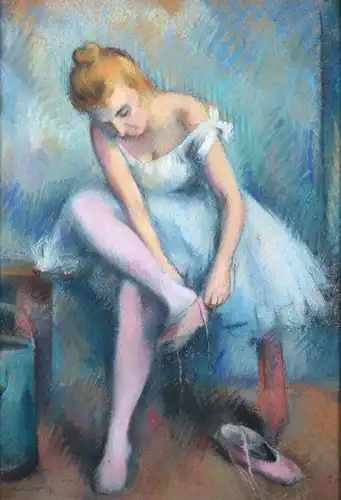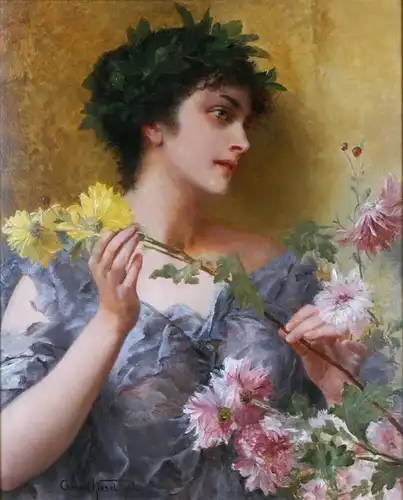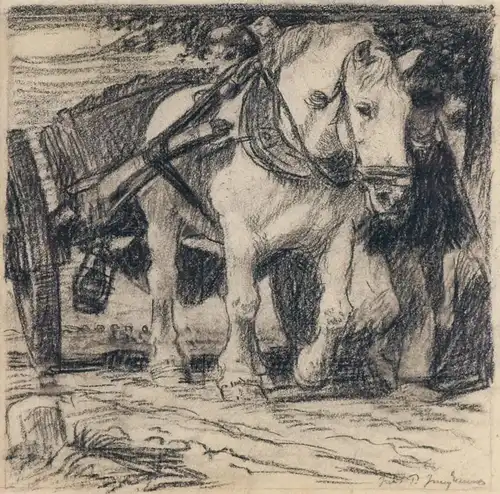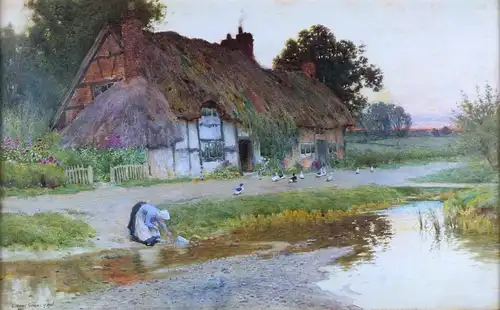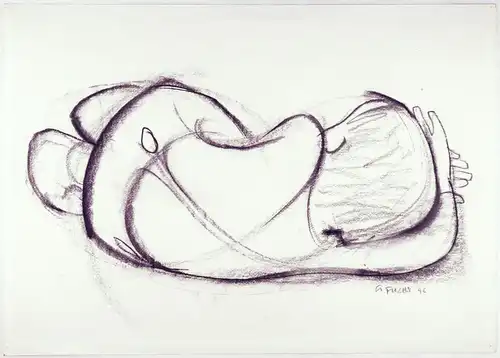Beschreibung
Karl Stohner (1894 Mannheim - 1957 Paris), Ballerina im Ankleideraum, 1924. Pastell auf Malkarton, 65 x 45 cm, 77,5 x 59,5 (Rahmen), unten links mit „Stohner“ signiert und auf „[19]24“ datiert. Hinter Glas im Goldstuckrahmen der Zeit.
- Malkarton leicht verzogen, im unteren Bereich minimal fleckig, Rahmen mit Alterspatina und Abriebspuren
- Die Natürlichkeit der Kunstform -
Wir sehen eine Ballerina, die sich den rechten Ballettschuh anzieht, während der linke noch vor ihr auf dem Boden liegt. Gerade aus der Beiläufigkeit der Szenerie speist sich ihre Intimität: Die blonde junge Frau geht ganz in der Tätigkeit auf, sich für den Tanz vorzubereiten, ohne uns dabei zu gewahren, während wir in dem für das Publikum unzugänglichen Umkleideraum genau vor ihr situiert sind und sie beim Ankleiden betrachten. Auch wenn sie noch keinen Tanzschritt vollführt, liegt in der gezeigten Handlung eine anmutige Eleganz, die im Gegensatz zur einstudierten Kunstform des Tanzes ganz natürlich wirkt. Die junge Frau präsentiert sich eben nicht in formvollendeter Bewegung vor einem Publikum, sondern vollführt eine ganz alltägliche Handlung, ohne zu wissen, dass sie dabei betrachtet wird. Konzentriert, beinahe hingebungsvoll zieht sie den Ballettschuh über die Verse und bemerkt nicht, dass ihr dabei ein Träger des Tutus von der Schulter gerutscht ist, was den erotischen Moment der Szene noch verstärkt.
Karl Stohner hat die an Edgar Degas inspirierte Darstellung in kräftigen Pastelltönen ausführt. Das dominierende Blau und Türkis verleiht der Szene etwas magisch Geheimnisvolles und ist ebenso wie das Rosa der Strümpfe und Ballettschuhe den von Degas dargestellten Tänzerinnen entlehnt. Degas Farben sind allerdings kühler temperiert, was sich insbesondere im hellen pastos aufgetragenen Inkarnat zeigt. Hier hält die Lebensfülle Auguste Renoirs Einzug ins Bild und lässt die Tänzerin ganz aus Fleisch und Blut erscheinen. Karl Stohner, der die Pastelle von Degas und Renoir intensiv studiert hat, vermählt hier beide Künstler miteinander und schafft damit eine eigene Bildsprache.
Den Hintergrund hat er in breiten Strichlagen angelegt, die farblich von Weiß über Türkis bis Dunkelblau reichen. Es entsteht eine musterförmige dynamische Struktur, die die ruhig in-sich-gekehrte Haltung der Frau konterkariert. Der Fonds nimmt gleichsam die Dynamik der Choreographie des Tanzes vorweg, auf den sich die Ballerina vorbereitet. Zugleich wird durch den Hintergrund der breite Pastellstrich als adäquates Malmittel thematisiert, die weiche fließende Eleganz er Tänzerin zu veranschaulichen.
zum Künstler
Entgegen dem Wunsch der wohlhabenden Eltern entschied sich Karl Stohner Maler zu werden. Sein Talent wurde vom Direktor der Mannheimer Kunsthalle, Fritz Wichert, entdeckt der ihn fortan förderte und Studienreisen unter anderem nach Paris finanzierte. Dort entdeckte er die Kunst von Degas, Cézanne und Renoir, die ihn in seinem Schaffen inspirierte.
ENGLISH VERSION
Karl Stohner (1894 Mannheim - 1957 Paris), Ballerina in the dressing room, 1924. Pastel on painting cardboard, 65 x 45 cm, 77,5 x 59,5 (frame), signed lower left "Stohner" and dated "[19]24". Behind glass in gold stucco frame of the time.
- Painting cardboard slightly warped, in the lower area minimally stained, frame with age patina and traces of abrasion.
- The Naturalness of Artificiality -
We see a ballerina putting on her right ballet shoe while the left one is still lying on the floor in front of her. It is precisely the casualness of the scene that gives it its intimacy: the blonde young woman is completely absorbed in the activity of getting ready for the dance, oblivious to us, while we are positioned right in front of her in the dressing room, inaccessible to the audience, watching her dress. Even though she does not yet perform a dance step, there is a graceful elegance in the action shown that seems quite natural in contrast to the rehearsed art form of dance. The young woman is not presenting herself to an audience in a perfectly formed movement, but is performing an everyday action, unaware that she is being watched. Concentrated, almost devotional, she pulls the ballet slipper over the verses, not noticing that one of the straps of the tutu has slipped off her shoulder, reinforcing the erotic moment of the scene.
Inspired by Edgar Degas, Karl Stohner has painted the scene in strong pastel tones. The dominant blues and turquoises give the scene a magical, mysterious quality and, like the pink of the stockings and ballet slippers, are borrowed from Degas's dancers. Degas's colors, however, are cooler tempered, which is particularly evident in the light impasto applied incarnate. This is where the vividness of Auguste Renoir comes into play, making the dancer seem entirely flesh and blood. Karl Stohner, who has studied the pastels of Degas and Renoir intensively, combines the two artists here to create his own pictorial language.
He has laid out the background in broad layers of strokes, ranging in color from white to turquoise to dark blue. The result is a dynamic, pattern-like structure that contrasts with the woman's calm, inward-looking posture. The fund anticipates the dynamics of the choreography of the dance for which the ballerina is preparing. At the same time, the broad pastel line in the background is an adequate means of painting to depict the soft, flowing elegance of the dancer.
About the artist
Against the wishes of his wealthy parents, Karl Stohner decided to become a painter. His talent was discovered by the director of the Mannheim Art Gallery, Fritz Wichert, who supported him from then on, including financing study trips to Paris. There he discovered the art of Degas, Cézanne and Renoir, which inspired his work.
